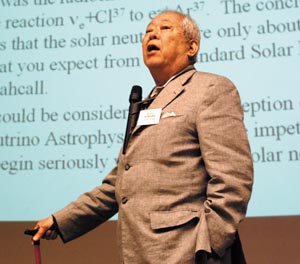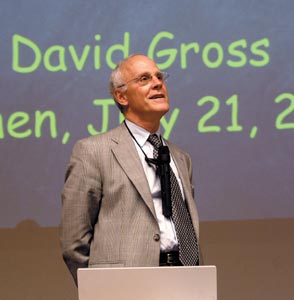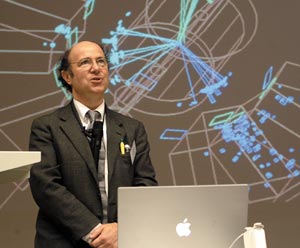The International Europhysics Conference on High Energy Physics of the European Physical Society (HEP-EPS) provided a superb synergy between physics, history and music, as Felicitas Pauss reports.

In the tradition of the HEP-EPS conferences, the meeting hosted this year by the University of Aachen on 17-23 July offered two well-balanced parts: three days of parallel sessions, followed by review talks from invited speakers. This formula, which also provides a forum for younger physicists, resulted in a rich and informative set of parallel sessions, illustrating the scientific progress made during the past two years. HEP 2003 also presented a good balance between news “coming from the Earth” (colliders and “terrestrial” neutrino physics) and results “coming from heaven” (astroparticle physics and cosmology).
The plenary meeting was opened by the presentations of EPS prizes to David Gross, David Politzer and Frank Wilczek (the High Energy and Particle Physics Prize), Nima Arkani-Hamed (the Gribov Medal), Guillaume Unal (the Young Physicist Prize), and Rolf Landua and Nicholas Tracas (the Outreach Prize). Also during the conference the EPS HEP Board held a special meeting and elected Jose Bernabeu of Valencia as its chairperson, who replaces Michel Spiro of IN2P3 in France.
The scientific plenary sessions began with a very stimulating talk on the birth of neutrino astrophysics by the 2002 Nobel laureate Masatoshi Koshiba of Tokyo. Pippa Wells of CERN then summarized the close-to-final results from the era of the Large Electron-Positron Collider (LEP) and the SLAC Linear Collider (SLC) and the impact they had on electroweak theory. In nearly all domains the quality and accuracy of the final results on Z and W physics were much better than predicted – as, for instance, at a meeting also held in Aachen, 16 years ago, as Daniel Treille from CERN recalled. Summarizing the whole set of available electroweak measurements by performing a global fit shows that the Standard Model (SM) accounts for the data in a satisfactory but imperfect way: the probability of the fit is only 4.5%. However, this value increases to 27.5% if the measurement of the weak mixing angle by the NuTeV experiment at Fermilab is excluded. This is the most outlying measurement, but it is suspected that there are “standard” explanations. The other noticeable disagreement unfortunately concerns the two most precise electroweak measurements, namely the spin asymmetry (ALR) at SLC and the forward-backward asymmetry of beauty production (AbFB) at LEP. These give values of the weak mixing angle differing by 2.9σ, with no hint of an explanation. Ignoring this disagreement and considering only the mean value of the results leads in the strict frame of the SM to the preferred Higgs mass region of mh = 91+58-37 GeV (mh ≤219 GeV at 95% CL).
An ambiguity that is not yet resolved concerns the theoretical interpretation of the muon g-2 measurement obtained in Brookhaven with an experimental accuracy of around 7 x 10-7. To predict its value requires the inclusion of subsidiary experimental data. Using the hadronic tau-decays leads to a fair agreement between theory and experiment, whereas using hadronic production in low-energy e+e– collisions results in an excess of around 2.5σ of experiment over expectation. This disagreement needs further study, especially because the g-2 observable is potentially a powerful sign of new physics, in particular of supersymmetry (SUSY).
Beyond the Standard Model
Moving on to the searches for new physics, Arnulf Quadt of Bonn gave an exhaustive review of the direct searches at colliders and updated the existing limits. Unfortunately, besides the DsJ particle found by the B-factories and the pentaquark (see “New five-quark states found at CERN”) – presented in a special talk by Frank Wilczek from MIT – no discovery has shown up at the high-energy frontier. Nevertheless, the motivation to go beyond the SM is more compelling than ever. Traditionally the routes leading beyond the SM either call for new levels of structure and/or new forces, as technicolour does, or involve an additional symmetry, as in the case of SUSY. Here SM particles and their “superpartners” conspire to solve the hierarchy problem.
While technicolour meets serious problems in passing the tests of electroweak measurements, SUSY, widely discussed in Aachen, keeps its eminent merits. An important and well-known result, derived from LEP data, is the quasi-perfect convergence near 1016 GeV of the electromagnetic, weak and strong coupling “constants” in the frame of SUSY.
it is important to appreciate correctly the existing limits, drawn either from accelerators or from astrophysics.
Daniel Treille
With the diversity of its possible breaking mechanisms, SUSY presents a complex phenomenology with many different mass spectra possible for the supersymmetric particles. However, its minimal version offers a golden test: it predicts a very light Higgs boson, i.e. ≤130 GeV (for mtop = 175 GeV) and even less for all versions of supergravity that are currently considered as reference points for the future. The final lower mass limit of direct searches at LEP is 114.4 GeV, with a 1.7σ effect near 115 GeV. The whole mass window could have been covered with 80 additional superconducting cavities (i.e. 30% more) and the magnificent performances of the accelerating field finally reached at LEP, and its exploration remains the first objective of future research programmes. If SUSY represents the truth, the Large Hadron Collider (LHC) at CERN, or maybe, with much luck and considerable improvements, the Tevatron at Fermilab, will discover SUSY by observing some supersymmetric particles besides the light Higgs boson. But a linear collider will be needed to complete precise measurements in the mass domain such a machine would access.
Other interesting new routes beyond the SM have appeared in recent years and were summarized by Lawrence Hall of Berkeley and Ferruccio Feruglio from Padova, while Jose Barbon of CERN presented the state of the art in the field of superstrings. The “little Higgs” scenario leaves aside the big hierarchy problem for the time being, and tackles first the small hierarchy one, namely the fact that LEP has suggested a light Higgs boson while it pushes beyond several tera-electron-volts all new physics (except SUSY, which can still be “behind the door”). The other new road postulates the existence of extra new dimensions of space, large enough to generate visible effects at future experiments. Such an eventuality- so far uncontradicted by experiments – has to be fully explored and would be an extraordinary opportunity for the LHC. However, as recalled by Treille, it is important to appreciate correctly the existing limits, drawn either from accelerators or from astrophysics.
QCD, beauty and heavy ions
Peter Schleper of Hamburg illustrated the numerous experimental successes of quantum chromodynamics (QCD), the theory of the strong interaction. The values of αS(MZ) obtained from very different sectors are now in very good agreement. The nucleon structure and the parton distributions are increasingly better known and understood, thanks especially to HERA at DESY. However, when spin intervenes, our understanding of hadrons is still poor. Pilar Hernandez of Valencia emphasized the progress of lattice simulations, which have become basic tools, crucial for many domains. It is important to underline that much remains to be done in matters of QCD if we are to enter the LHC era in optimal conditions, i.e. with a very good understanding of the SM prediction for the many different topologies that searches will explore. This is particularly true for the indispensable Monte Carlo programs.

Sheldon Stone of Syracuse and Hitoshi Yamamoto of Tohuku described in great detail the impressive progress of beauty physics. One must first underline the remarkable performances of the B-factories, in particular of KEKB in Japan, the first machine to deliver a luminosity of 1034 cm-2 s-1. It is clear that a very successful first round of experiments has been accomplished. The direct measurement of one of the angles of the unitary triangle (called ß or φ1, depending on the continent) via the very clean mode B → J/Ψ KS is in excellent agreement with the determination of the tip of the triangle through the measurement of its sides made during the past decade from B and K physics results at LEP and elsewhere. This is another important success of the SM.
However, revealing new physics calls for a much better accuracy. The roadmap, concerning this second round of measurements, defines an ambitious programme, which involves many different beauty decay modes and is extremely demanding from the experimental as well as from the theory side, as described in detail by Thomas Mannel from Karlsruhe. Equally promising are rare K and µ decay modes where the expected performance is very impressive indeed, as for instance in future searches at the Paul Scherrer Institute (PSI) for µ → eγ with a sensitivity of 10-14.
Saskia Mioduszewski from Brookhaven reviewed results coming from gold-gold collisions up to 200 A GeV produced at Brookhaven’s Relativistic Heavy Ion Collider (RHIC). The most prominent signatures that could reveal a quark-gluon plasma are not yet available from RHIC, but results are still coming from the Super Proton Synchrotron (SPS) at CERN. For example, the J/Ψ suppression, confirmed by the analyses of CERN’s NA50 experiment, keeps all its interest. Unfortunately no unique prediction of this effect exists for RHIC and the LHC. More data are needed: the next should come from the PHENIX experiment at RHIC and from NA60 at CERN.
Hitoshi Murayama and Kevin Lesko, Berkeley, shared the review of neutrino physics, which is in a truly revolutionary era. After the triumph of the SuperKamiokande experiment in Japan, the recent results of the KEK to Kamioka (K2K) neutrino-oscillation experiment, the Sudbury Neutrino Observatory (SNO) and the Japanese reactor experiment KamLAND have strengthened our knowledge of neutrino oscillations. The main open question is whether there exists a fourth neutrino, of a sterile nature, as suggested by the Liquid Scintillator Neutrino Detector (LSND) at Los Alamos, but strongly disfavoured by the other results. Fermilab’s MiniBooNE experiment will settle the matter in the coming years. The big unknown now is the magnitude of the third mixing angle θ13 of the neutrino-mixing matrix. Its value will reveal if the ultimate stage in neutrino physics, namely the measurement of CP violation in this sector, is accessible or not.
Oscillations give access only to mass differences. To know the absolute mass values one must consider the beta decay of tritium, which, through its end-point, gives access to mνe (present limit at 2.2 eV from Mainz and Troitsk, future one near 0.2 eV from KATRIN in Karlsruhe), and neutrinoless double beta decay. The existence of the latter would imply that the neutrino is of Majorana type. Interesting news concerning neutrino physics also came from cosmology. A combination of the results from the Wilkinson Microwave Anisotropy Probe (WMAP) and the 2dF Galaxy Redshift Survey seems to indicate that Σmνi ≤0.71 eV. This limit implies a mass range for the heaviest neutrino of 0.03 ≤m3 ≤0.24 eV (95% CL). However, at the meeting Steen Hannestad of Odense called for some caution in deriving such limits.
Cosmic particles
Astroparticle physics, covered partly by the plenary talk of Stefan Schael from Aachen and quite abundantly in parallel sessions, is a vast domain, now concerning all types of particles. One of the goals is to extract information about cosmological objects or events, and the number of such non-accelerator research programmes is increasing very rapidly.
The enigma of ultrahigh-energy cosmic rays, beyond the Greisen-Zatsepin-Kuzmin (GKZ) cut-off, remains unsolved. Even their existence is still to be demonstrated definitively, as current experiments cannot settle the issue. The Pierre Auger Observatory, now in its initial phase (see “Auger ready for ultra-high-energy cosmic rays”), should provide the answer and perhaps say something about their nature. The main objective of gamma astronomy, on the other hand, is to fill the gap between low energies (a few giga-electron-volts, the domain of satellites) and high ones (a few hundred giga-electron-volts, the threshold of ground-based detectors up to now). Preliminary results from HESS in Namibia and the imminent start of MAGIC on La Palma (see “MAGIC opens up the gamma-ray sky”) were reported in the parallel sessions. Astrophysics of high-energy neutrinos, detected either by atmospheric Cherenkov telescopes, such as AUGER and the Extreme Universe Space Observatory (EUSO) under study, or by sub-ice experiments, such as AMANDA and its successor ICECUBE at the south pole, and submarine experiments, such as ANTARES in the Mediterranean Sea and NESTOR in Greece, is certainly a fascinating objective. However, the proof of principle has still to be demonstrated and no detection of high-energy neutrinos of extra-terrestrial origin has been reported so far.
The content of the universe
As for cold dark matter, whose contribution to the content of the universe has been accurately determined by WMAP (23%), the search is in full swing. For the baryonic part (4.4%), the possibility that it could be due mostly to dark objects like “failed stars” is now excluded. Instead, gas and dust may be the answer. For non-baryonic dark matter, the neutralino (the lightest SUSY particle) and the axion are still the favoured candidates. The DAMA experiment at the Gran Sasso National Laboratory (LNGS), now with a further year of data, continues to present a result that suggests a seasonal variation in its counting rate, for a very low threshold. An unidentified systematic effect is not excluded and it is important to confirm this observation in an independent manner. Neither the Cryogenic Dark Matter Search (CDMS) nor the EDELWEISS experiment under the French Alps confirms it, and at first sight they seem to exclude the mass and cross-section regions corresponding to the DAMA effect. However, this conclusion has to be considered with caution, given the very low threshold used by DAMA, as well as the potential role of spin-dependent interactions.

A striking result from 2003, well illustrated in Aachen by Schael, is WMAP’s measurement of the power spectrum of the microwave background with a much better accuracy than previously. From the position and the respective heights of the observed peaks, a large number of cosmological parameters have been extracted with an impressive accuracy. The flatness of the universe seems in particular to be proven without ambiguity. As Viatcheslav Mukhanov of Munich underlined in his lively talk, WMAP appears to have confirmed two of the three major predictions of inflation: the flatness of the universe, linked to the superluminal expansion, and the existence of density perturbations corresponding to a quasi scale-invariant spectrum (inflation actually predicts a slight deviation from invariance, which still needs experimental confirmation). The third prediction, the existence of gravitational waves originating from inflation, is out of reach of the interferometer experiments, including the space mission LISA. However, relevant information can come from the experimental programmes able to measure the cosmic microwave background radiation (CMBR) polarization, in particular WMAP itself and, later, the PLANCK mission. On the contrary, the various models of inflation on the market are still rather unconstrained by the present data and the nature of the inflation remains a deep mystery.
R&D on the road ahead
The most innovative aspects of instrumentation were reviewed by Daniel Fournier of Orsay. All the breakthroughs he described could happen only as a result of long and vigorous R&D activity: its continuation is a key for the future of our field. As David Stickland of Princeton illustrated, this must be accompanied by a mutation of the computing means and of the distribution of information on a worldwide scale: this is the aim of the Grid.
An important part of the conference was devoted to the Road Map for High Energy Physics discussed in a joint session of the European Committee for Future Accelerators (ECFA) and EPS. This round table was supplemented by a comprehensive review from Cornell’s Maury Tigner of accelerator R&D. The near future is clearly dominated by the LHC, which should start up in 2007. It is well-known, but it is important to recall the challenge of the LHC (the machine as well as the detectors), the vital importance of its success and the enormous physics potential it offers. Given the timescale that a new project implies, it is however crucial to plan the longer-term future. The choice of an e+e– linear collider, which should complement the LHC through the accuracy of its measurements, is unanimous. This too is a difficult enterprise that requires intense accelerator R&D, as Tigner discussed. He also argued for a stronger involvement by high-energy physicists in the R&D of accelerator physics. This important suggestion – influencing the future of particle physics – should be supported.
Treille gave an impressive conference summary. He highlighted the most important results presented and included additional information, thus giving a very comprehensive overview of the present status and future perspectives of our field. The résumé presented here is certainly influenced by this concluding talk.
This conference in the beautiful town of Aachen was organized in an exemplary way. The participants enjoyed not only a very stimulating conference, but also a welcome reception by the city of Aachen in the “Aula Carolina”, a place of ancestral dignity, and an exceptional event on Monday evening – a performance of Verdi’s La Traviata, arranged specially for this conference. Christoph Berger and his local organizing committee did an outstanding job indeed. They have set high standards for the forthcoming 2005 EPS HEP conference, which will take place in Portugal.







